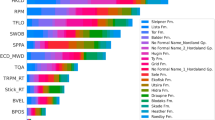Abstract
Air pollution has emerged as an imminent issue in modernsociety. Prediction of pollutant levels is an importantresearch topic in atmospheric environment today. For fulfillingsuch prediction, the use of neural network (NN), and inparticular the multi-layer perceptrons, has presented to be acost-effective technique superior to traditional statisticalmethods. But their training, usually with back-propagation (BP)algorithm or other gradient algorithms, is often with certaindrawbacks, such as: 1) very slow convergence, and 2) easilygetting stuck in a local minimum. In this paper, a newlydeveloped method, particle swarm optimization (PSO) model, isadopted to train perceptrons, to predict pollutant levels, andas a result, a PSO-based neural network approach is presented. The approach is demonstrated to be feasible and effective bypredicting some real air-quality problems.
Similar content being viewed by others
References
Angeline, P. J.: 1998, Evolutionary Optimization Versus Particle Swarm Optimization: Philosophy and Performance Differences, Evolutionary Programming, VII, 601–610. Berlin: Springer.
Boznar, M., Lesjak, M. and Mlakar, P.: 1993, ‘A neural network-based method for short-term predictions of ambient SO concentrations in highly polluted industrial areas of complex terrain’, Atmos. Environ. B 27(2), 221–230.
Comrie, A. C.: 1997, ‘Comparing neural networks and regression models for ozone forecasting’, J. Air Waste Manage. 47, 653–663.
Eberhart, R. and Kennedy, J.: 1995, ‘A New Optimizer Using Particle Swarm Theory, Sixth International Symposium on Micro Machine and Human Science, 39–43.
Fan, H. Y., Lu, W. Z. and XU, Z. B.: 2000, ‘An empirical comparison of three novel genetic algorithms’, Engin. Comput. 17(8), 981–1001.
Gardner, M. W. and Dorling, S. R.: 1996, ‘Neural Network Modelling of the Influence of Local Meteorology on Surface Ozone Concentrations’, Proceedings 1st International Conference on GeoComputation, University of Leeds, UK, 359–370.
Gardner, M. W. and Dorling, S. R.: 1998, ‘Artificial neural networks (the multi-layer perceptron) ¶ a review of applications in the atmospheric science’, Atmos. Environ. 30(14/15), 2627–2636.
Hornik, K., Stinchcombe, M. and White, H.: 1989, ‘Multi-layer feedforward networks are universal approximators’, Neural Networks 2, 359–366.
Kennedy, J. and Eberhart, R. C.: 1995, ‘Particle Swarm Optimization’, Proceeding of the 1995 IEEE International Conference on Neural Networks, 1942¶1948, IEEE Service Center, Piscataway, NJ.
Kennedy, J.: 1997, ‘The Particle Swarm: Social Adaptation of Knowledge’, Proceeding of the 1997 International Conference on Evolutionary Computation (Indianapolis, Indiana), 303–308, IEEE Service Center, Piscataway, NJ.
Lu, W. Z., Fan, H. Y., Lo, S. M., Leung, A. Y. T., Yuen, K. K. and Wong, J. C. K.: 2001, ‘A Particle-Swarm-Optimization-Based Neural Network Approach and its Application to Environmental Modeling’, Proceedings of IAQVEC'2001. I, 405–412, 2¶5 October, Changsha, PR China.
Reich, S. L., Gomez, D. R. and Dawidowski, L. E.: 1999, ‘Artificial neural network for the identification of unknown air pollution sources’, Atmos. Environ. 33, 3045–3052.
Roadknight, C. M., Balls, G. R., Mills, G. E. and Palmer-Brown, D.: 1997, ‘Modeling complex environmental data’, IEEE Transactions Neural Networks 8(4), 852–861.
Schwartz, J.: 1996, ‘Air pollution and hospital admissions for respiratory disease’, Epidemio. 7, 20–28.
Song, X. H. and Hopke P. K.: 1996, ‘Solving the chemical mass balance problem using an artificial neural network’, Environ. Sci. Technol. 30(2), 531–535.
Tiittanen, P., Timonen, K. L., Ruuskanen, J., Mirme, A. and Pekkanen, J.: 1999, ‘Fine particulate air pollution, resuspended road dust and respiratory health among symptomatic children’, Europ. Respiratory J. 13, 266–273.
Yi, J and Prybutok, R.: 1996, ‘A neural network model forecasting for prediction of daily maximum ozone concentration in an industrialized urban area’, Environ. Poll. 92(3), 349–357.
Author information
Authors and Affiliations
Corresponding author
Rights and permissions
About this article
Cite this article
Lu, W.Z., Fan, H.Y., Leung, A.Y.T. et al. Analysis of Pollutant Levels in Central Hong Kong Applying Neural Network Method with Particle Swarm Optimization. Environ Monit Assess 79, 217–230 (2002). https://doi.org/10.1023/A:1020274409612
Issue Date:
DOI: https://doi.org/10.1023/A:1020274409612




